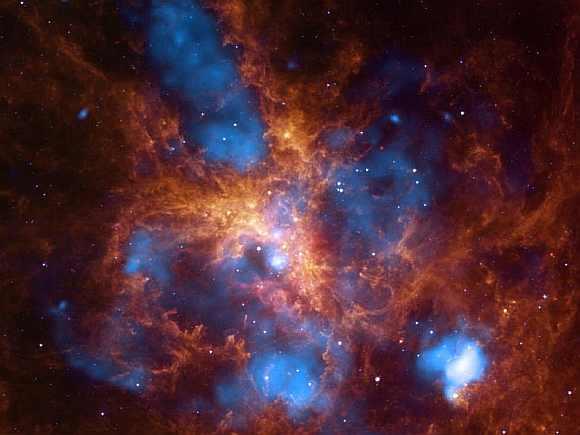
Rediff.com brings you a collection of never-seen-before pictures released by the National Aeronautics and Space Administration of some of the most massive and magnificent stars, supernovas and nebulas in our galactic neighbourhood.
NASA and the Space Telescope Science Institute in Baltimore have released a new image of 30 Doradus, a star-forming complex located in the heart of the Tarantula nebula, in celebration of Hubble Space Telescope's 22nd anniversary.
30 Doradus is the brightest star-forming region in our galaxy and around and home to the most massive stars ever seen.
30 Doradus is also known as an HII (pronounced H-two) region, created when the radiation from hot, young stars strips away the electrons from neutral hydrogen atoms to form clouds of ionised hydrogen. It is the most massive and largest HII region in the Local Group of galaxies, which contains the Milky Way, Andromeda and about 30 other smaller galaxies including the two Magellanic Clouds.
...

This new view of the Orion nebula highlights fledgling stars hidden in the gas and clouds. It shows infrared observations taken by NASA's Spitzer Space Telescope and the European Space Agency's Herschel mission, in which NASA plays an important role.
A star forms as a clump of this gas and dust collapses, creating a warm glob of material fed by an encircling disk. These dusty envelopes glow brightest at longer wavelengths, appearing as red dots in this image. In several hundred thousand years, some of the forming stars will accrete enough material to trigger nuclear fusion at their cores and then blaze into stardom.
The nebula is found below the three belt stars in the famous constellation of Orion the Hunter, which appears at night in northern latitudes during fall and then throughout winter.

This image shows the Large Magellanic Cloud galaxy in infrared light as seen by the Herschel Space Observatory, a European Space Agency-led mission with important NASA contributions, and NASA's Spitzer Space Telescope. In the instruments' combined data, this nearby dwarf galaxy looks like a fiery, circular explosion.
Rather than fire, however, those ribbons are actually giant ripples of dust spanning tens or hundreds of light-years. Significant fields of star formation are noticeable in the center, just left of center and at right. The brightest center-left region is called 30 Doradus, or the Tarantula Nebula, for its appearance in visible light.
The colours in this image indicate temperatures in the dust that permeates the cloud.

A bubbling cauldron of star birth is highlighted in this image from NASA's Spitzer Space Telescope. Infrared light that we can't see with our eyes has been color-coded, such that the shortest wavelengths are shown in blue and the longest in red. The middle wavelength range is green.
Massive stars have blown bubbles, or cavities, in the dust and gas -- a violent process that triggers both the death and birth of stars. The brightest, yellow-white regions are warm centers of star formation. The green shows tendrils of dust, and red indicates other types of dust that may be cooler, in addition to ionized gas from nearby massive stars.
Cygnus X is about 4,500 light-years away in the constellation Cygnus, or the Swan
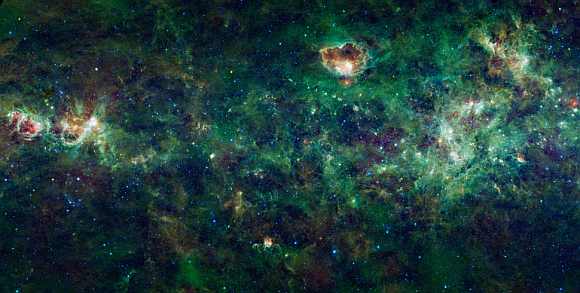
This enormous section of the Milky Way galaxy is a mosaic of images from NASA's Wide-field Infrared Survey Explorer, or WISE. The constellations Cassiopeia and Cepheus are featured in this 1,000-square degree expanse.
These constellations, named after an ancient Queen and King of Ethiopia in Greek mythology, are visible in the northern sky every night of the year as seen from most of the United States.
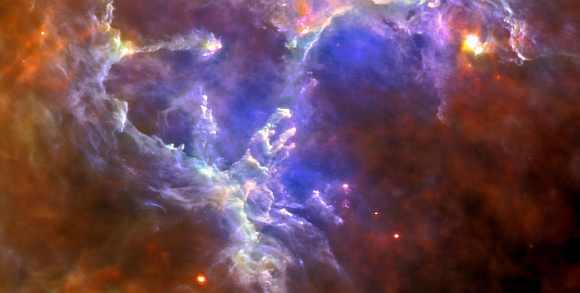
This Herschel image of the Eagle nebula shows the self-emission of the intensely cold nebula's gas and dust as never seen before. Each color shows a different temperature of dust.
Herschel reveals the nebula's intricate tendril nature, with vast cavities forming an almost cave-like surrounding to the famous pillars, which appear almost ghostly in this view. The gas and dust provide the material for the star formation that is still under way inside this enigmatic nebula.
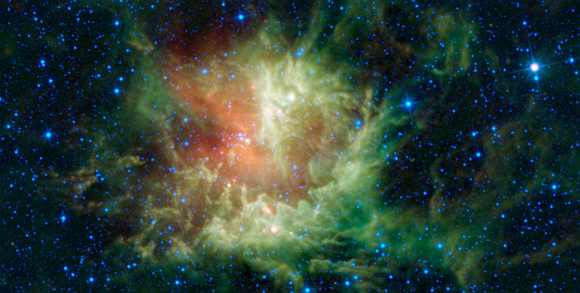
In visible light, the star-forming cloud catalogued as NGC 281 in the constellation of Cassiopeia appears to be chomping through the cosmos, earning it the nickname the Pacman nebula after the famous Pac-Man video game of the 1980s.
NGC 281 is a giant cloud of dust and gas located about 9,200 light-years away within our own Milky Way galaxy, and spans about 130 light-years in space. Inside the cloud, a new cluster of stars is forming. This young cluster, called IC 1590, appears as a group of stars near the center of the red and green cloud in the upper portion of the image.
Within the cluster there are several very massive stars, many times the mass of the sun. These stars are also very hot and produce large amounts of ultraviolet radiation and blow strong winds. The radiation and winds erode the larger cloud from the inside out, giving it a shell-like appearance. The winds and radiation heat the dust in the cloud, which then glows in infrared light. The wavelength at which the dust glows depends on the temperatures.

This image combines data from four different space telescopes to create a multi-wavelength view of all that remains of the oldest documented example of a supernova, called RCW 86. The Chinese witnessed the event in 185 AD, documenting a mysterious "guest star" that remained in the sky for eight months.
X-ray images from the European Space Agency's XMM-Newton Observatory and NASA's Chandra X-ray Observatory are combined to form the blue and green colours in the image. The X-rays show the interstellar gas that has been heated to millions of degrees by the passage of the shock wave from the supernova.
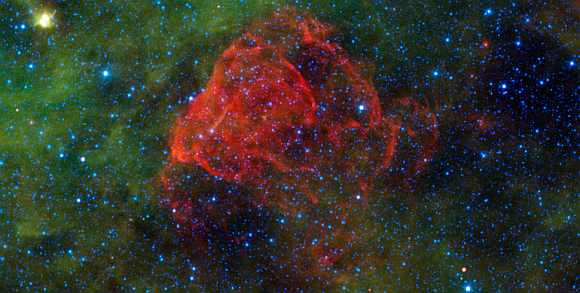
Seen as a red dusty cloud in this image from NASA's wide-field infrared survey explorer, Puppis A is the remnant of a supernova explosion.
About 3,700 years ago people on Earth would have seen a brand-new bright star in the sky. As it slowly dimmed out of sight, it was eventually forgotten, until modern astronomers found its remains -- called Puppis A. Seen as a red dusty cloud in this image from NASA's wide-field infrared survey explorer, or WISE, Puppis A is the remnant of a supernova explosion.

A quartet of Saturn's moons, from tiny to huge, surround and are embedded within the planet's rings in this Cassini composition. Saturn's largest moon, Titan, is in the background of the image, and the moon's north polar hood is clearly visible.

This vibrant image from NASA's Spitzer Space Telescope shows the Large Magellanic Cloud, a satellite galaxy to our own Milky Way galaxy.
The infrared image, a mosaic of 300,000 individual tiles, offers astronomers a unique chance to study the lifecycle of stars and dust in a single galaxy.

This image from ESA's Herschel Space Observatory reveals a suspected ring at the center of our galaxy is warped for reasons scientists cannot explain.
In a strange twist of science, astronomers using the Herschel Space Observatory have discovered that a suspected ring at the center of our galaxy is warped for reasons they cannot explain. This image from Herschel, an infrared European Space Agency-led mission with important NASA contributions, reveals the ring with greater clarity than ever before.
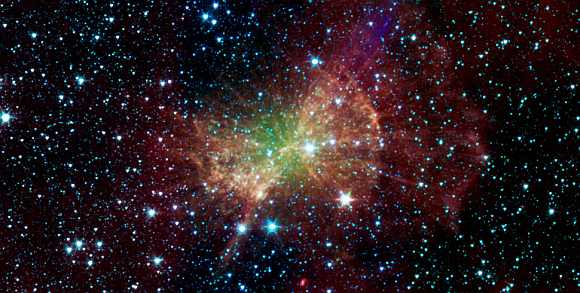
The Dumbbell nebula' also known as Messier 27, pumps out infrared light in this image from NASA's Spitzer Space Telescope.
The nebula was named after its resemblance to a dumbbell as seen in visible light. It was discovered in 1764 by Charles Messier, who included it as the 27th member of his famous catalog of nebulous objects. Though he did not know it at the time, this was the first in a class of objects, now known as "planetary nebulae," to make it into the catalog.
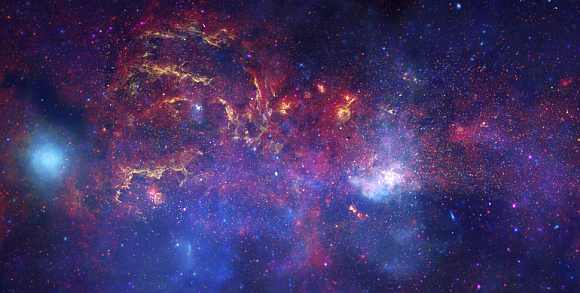
In celebration of the International Year of Astronomy 2009, NASA's Great Observatories -- the Hubble Space Telescope, the Spitzer Space Telescope, and the Chandra X-ray Observatory -- have produced a matched trio of images of the central region of our Milky Way galaxy.
Each image shows the telescope's different wavelength view of the galactic center region, illustrating the unique science each observatory conducts.

This enhanced-color image from NASA's Mars Reconnaissance Orbiter shows sand dunes trapped in an impact crater in Noachis Terra, Mars.
Dunes and sand ripples of various shapes and sizes display the natural beauty created by physical processes. The area covered in the image is about six-tenths of a mile (1 kilometer) across.
Sand dunes are among the most widespread wind-formed features on Mars. Their distribution and shapes are affected by changes in wind direction and wind strength. Patterns of dune erosion and deposition provide insight into the sedimentary history of the surrounding terrain.
...